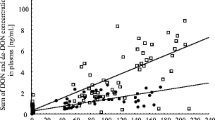Abstract
In a commercial breeding herd of 140 sows, the introduction of a lot of ensiled corn cob mix (CCM) contaminated with 6–11 mg deoxynivalenol and 3–5 mg zearalenone per kg dry matter (DM) into the ration of the pregnant sows and of the gilts immediately decreased its palatability. The contaminated CCM in the ration was reduced from 60% to 40% in the DM after 1 month and was completely eliminated after a further 2.5 months. The reproductive performance data of the herd during the 5 months after the introduction of the contaminated CCM (e.g. 88% non-return rate, 10.2 weaned piglets per litter, no abortion, no pseudopregnancy) were similar to the data obtained for the same period of the previous year. The high mycotoxin exposure thus had no obvious negative effects on fertility.
Similar content being viewed by others
References
Aaron DK, Hays VW (2001) Statistical techniques for the design and analysis of swine nutrition experiments. In: Lewis AJ, Southern LL (eds) Swine nutrition, 2nd edn. CRC Press, Boca Raton, pp 881–901
Bauer J, Heinritzi K, Gareis M, Gedek B (1987) Veränderungen am Genitaltrakt des weiblichen Schweines nach Verfütterung praxisrelevanter Zearalenonmengen. Tierarztl Prax 15:33–36
Chavez ER (1984) Vomitoxin-contaminated wheat in pig diets: pregnant and lactating gilts and weaners. Can J Anim Sci 64:717–723
Côté LM, Reynolds JD, Vesonder RF, Buck WB, Swanson SP, Coffey RT, Brown DC (1984) Survey of vomitoxin-contaminated feed grains in midwestern United States, and associated health problems in swine. JAVMA 184:189–192
Dänicke S, Goyarts T, Valenta H (2007) On the specific and unspecific effects of a polymeric glucomannan mycotoxin adsorbent on piglets when fed with uncontaminated or with Fusarium contaminated diets. Arch Anim Nutr 61:266–275. doi:10.1080/17450390701431854
Dersjant-Li Y, Verstegen MW, Gerrits WJ (2003) The impact of low concentrations of aflatoxin, deoxynivalenol or fumonisin in diets on growing pigs and poultry. Nutr Res Rev 16:223–239. doi:10.1079/NRR200368
Diaz-Llano G, Smith TK (2006) Effects of feeding grains naturally contaminated with Fusarium mycotoxins with and without a polymeric glucomannan mycotoxin adsorbent on reproductive performance and serum chemistry of pregnant gilts. J Anim Sci 84:2361–2366. doi:10.2527/jas.2005-699
Diekman MA, Green ML (1992) Mycotoxins and reproduction in domestic livestock. J Anim Sci 70:1615–1627
Döll S, Dänicke S, Ueberschaer KH, Valenta H, Schnurrbusch U, Ganter M, Klobasa F, Flachowsky G (2003) Effects of graded levels of Fusarium toxin contaminated maize in diets for female weaned piglets. Arch Anim Nutr 57:311–334. doi:10.1080/00039420310001607680
Eriksen GS, Pettersson H (2004) Toxicological evaluation of trichothecenes in animal feed. Anim Feed Sci Techn 114:205–239
Etienne M, Jemmali M (1982) Effects of zearalenone (F2) on estrous activity and reproduction in gilts. J Anim Sci 55:1–10
Etienne M, Oswald I, Bony S, Lallès JP, Pinton P, Trépier B, Lessard M (2006) Effets de la contamination par le déoxynivalénol (DON) de l’aliment des truies reproductrices. Journées Recherche Porcine 38:233–240
European Commission (2006) Commission recommendation of 17 August 2006 on the presence of deoxynivalenol, zearalenone, ochratoxin, T-2 and HT-2 and fumonisin in products intended for animal feeding. Off J Eur Union L. 229:7-9
Fink-Gremmels J, Malekinejad H (2007) Clinical effects and biochemical mechanisms associated with exposure to the mycoestrogen zearalenone. Anim Feed Sci Techn 137:326–341
Friend DW, Trenholm HL, Thompson BK, Fiser PS, Hartin KE (1986) Effect of feeding diets containing deoxynivalenol (vomitoxin) contaminated wheat or corn on the consumption, weight gain, organ weight and sexual development of male and female pigs. Can J Anim Sci 66:765–775
Gallaher DD, Schneeman BO (2001) Dietary fiber. In: Bowman BA, Russel RM (eds) Present knowledge in nutrition, 8th edn. ILSI Press, Washington D.C., pp 83–91
Green ML, Diekman MA, Malayer JR, Scheidt AB, Long GG (1990) Effect of prepubertal consumption of zearalenone on puberty and subsequent reproduction of gilts. J Anim Sci 68:171–178
Jadamus A, Schneider D (2002) Long-term effect of fusariotoxins on the reproductive performance of sows. Feed Magazine 10:396–405
Lepom P, Baath H, Knabe O (1988) Vorkommen von Fusarium-Arten und ihren Mykotoxinen auf Silomais. 3. Mitteilung. Der Einfluss der Silierung auf den Zearalenongehalt von CCM-Mais. Arch Anim Nutr 38:817–823
Long GG, Diekman M, Tuite JF, Shannon GM, Vesonder GF (1982) Effect of Fusarium roseum culture containing zearalenone on early pregnancy in swine. Am J Vet Res 43:1599–1603
Niderkorn V, Morgavi DP, Pujos E, Tissandier A, Boudra H (2007) Screening of fermentative bacteria for their ability to biotransform deoxynivalenol, zearalenone and fumonisins in an in vitro simulated corn silage model. Food Add Contam A 24:406–415
Rainey MR, Tubbs RC, Bennett LW, Cox NM (1990) Prepubertal exposure to dietary zearalenone alters hypothalamo-hypophysial function but does not impair postpubertal reproductive function of gilts. J Anim Sci 68:2015–2022
Smith JF, di Menna ME, McGowan LT (1990) Reproductive performance of Coopworth ewes following oral doses of zearalenone before and after mating. J Reprod Fertil 89:99–106
Swamy H, Smith T, MacDonald E, Boermans H, Squires E (2002) Effects of feeding a blend of grains naturally contaminated with Fusarium mycotoxins on swine performance, brain regional neurochemistry and serum chemistry, and the efficacy of a polymeric glucomannan mycotoxin adsorbent. J Anim Sci 80:3257–3267
Swamy H, Smith K, MacDonald E, Karrow N, Woodward B, Boermans H (2003) Effects of feeding a blend of grains naturally contaminated with Fusarium mycotoxins on growth and immunological measurements of starter pigs, and the efficacy of a polymeric glucomannan adsorbent. J Anim Sci 81:2792–2803
Young LG, King GJ (1986) Low concentrations of zearalenone in diets of mature gilts. J Anim Sci 63:1191–1196
Young LG, King GJ, McGirr L, Sutton JC (1982) Moldy corn in diets of gestating and lactating swine. J Anim Sci 54:976–982
Author information
Authors and Affiliations
Corresponding author
Rights and permissions
About this article
Cite this article
Gutzwiller, A., Gafner, JL. Fertility of sows exposed to zearalenone and deoxynivalenol—a case report. Mycotox Res 25, 21–24 (2009). https://doi.org/10.1007/s12550-008-0003-x
Received:
Revised:
Accepted:
Published:
Issue Date:
DOI: https://doi.org/10.1007/s12550-008-0003-x



